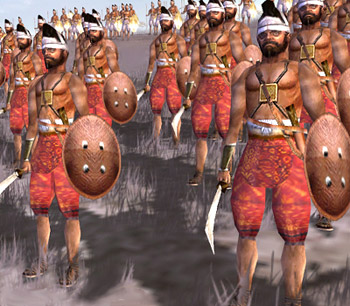 Indian Army under the Mauryan rule mainly consisted of a commission of thirty members. The departments of supply and admiralty were considered to be an innovation introduced by Chandra Gupta Maurya. In Mauryan times the agricultural classes were exempt from military service but had to join in times of national emergency. According to Megasthenese, the fighting class came next only to the cultivators in number. These were given regular pay even in peace times. Tradesmen like artisans, ship-builders and armour makers could not serve private individuals and were state employees. The hereditary or the regular army formed the back-bone of the defence organisation under Mauryan rule and was very well equipped.
Indian Army under the Mauryan rule mainly consisted of a commission of thirty members. The departments of supply and admiralty were considered to be an innovation introduced by Chandra Gupta Maurya. In Mauryan times the agricultural classes were exempt from military service but had to join in times of national emergency. According to Megasthenese, the fighting class came next only to the cultivators in number. These were given regular pay even in peace times. Tradesmen like artisans, ship-builders and armour makers could not serve private individuals and were state employees. The hereditary or the regular army formed the back-bone of the defence organisation under Mauryan rule and was very well equipped.
It has been found that the army organisation in ancient India had reached a very high standard of efficiency and in its basic essentials were the fore-runner of the standards witnessed in the country later. It was this efficient system that enabled Chandragupta Maurya to extend his dominions from Afghanistan in the northwest to Bengal in the east and from the Himalayas in the north to the Vindhya Mountain Ranges in the south. With his superior forces he also outmatched Seleukos Nikator and forced upon him a humiliating treaty. In his northern campaigns around 303 BC he was able to claim the satrapies of Aria (Herat), Paropanisadai (Kabul), Arachosia (Kandhar) and Gedrosia (Makran) from the Greeks, thus extending the frontiers to the foot of the Hindu Kush Mountains. This was a great achievement as with these gains he obtained possession of that scientific frontier sighed for in vain by all his successors in the country for the next 2,000 years. During the Mughal period they did make some inroads into that area but their possessions were short lived.
The terrible war waged by Ashoka not long after his accession for the conquest of Kalinga was an important event of his reign. It is recorded that about 100,000 men were slain on the battle field and one and half times that number were taken prisoners. According to historians, the spread of Buddhism with its cult of ahimsa and the conversion of Ashoka with an emphasis on dharma vijaya (conquest conformable to religion) have seriously affected the martial ardour and efficiency of his government and people. After Ashoka, Magadha ceased to be the seat of a powerful military government as it was before he took over. During the Mauryan period the armies of the various Indian rulers and republics were organised on the same basis as before. The art of war continued to enjoy a predominant place.




















